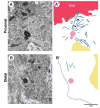Asymmetric inheritance of mother versus daughter centrosome in stem cell division
- PMID: 17255513
- PMCID: PMC2563045
- DOI: 10.1126/science.1134910
Asymmetric inheritance of mother versus daughter centrosome in stem cell division
Abstract
Adult stem cells often divide asymmetrically to produce one self-renewed stem cell and one differentiating cell, thus maintaining both populations. The asymmetric outcome of stem cell divisions can be specified by an oriented spindle and local self-renewal signals from the stem cell niche. Here we show that developmentally programmed asymmetric behavior and inheritance of mother and daughter centrosomes underlies the stereotyped spindle orientation and asymmetric outcome of stem cell divisions in the Drosophila male germ line. The mother centrosome remains anchored near the niche while the daughter centrosome migrates to the opposite side of the cell before spindle formation.
Figures




Comment in
-
Developmental biology. The mother of all stem cells?Science. 2007 Jan 26;315(5811):469-70. doi: 10.1126/science.1138237. Science. 2007. PMID: 17255500 No abstract available.
References
-
- Morrison SJ, Kimble J. Nature. 2006;441:1068. - PubMed
-
- Spradling A, Drummond-Barbosa D, Kai T. Nature. 2001;414:98. - PubMed
-
- Watt FM, Hogan BLM. Science. 2000;287:1427. - PubMed
-
- Kiger AA, Jones DL, Schulz C, Rogers MB, Fuller MT. Science. 2001;294:2542. - PubMed
-
- Tulina N, Matunis E. Science. 2001;294:2546. - PubMed
Publication types
MeSH terms
Substances
Grants and funding
LinkOut - more resources
Full Text Sources
Other Literature Sources
Medical
Molecular Biology Databases

